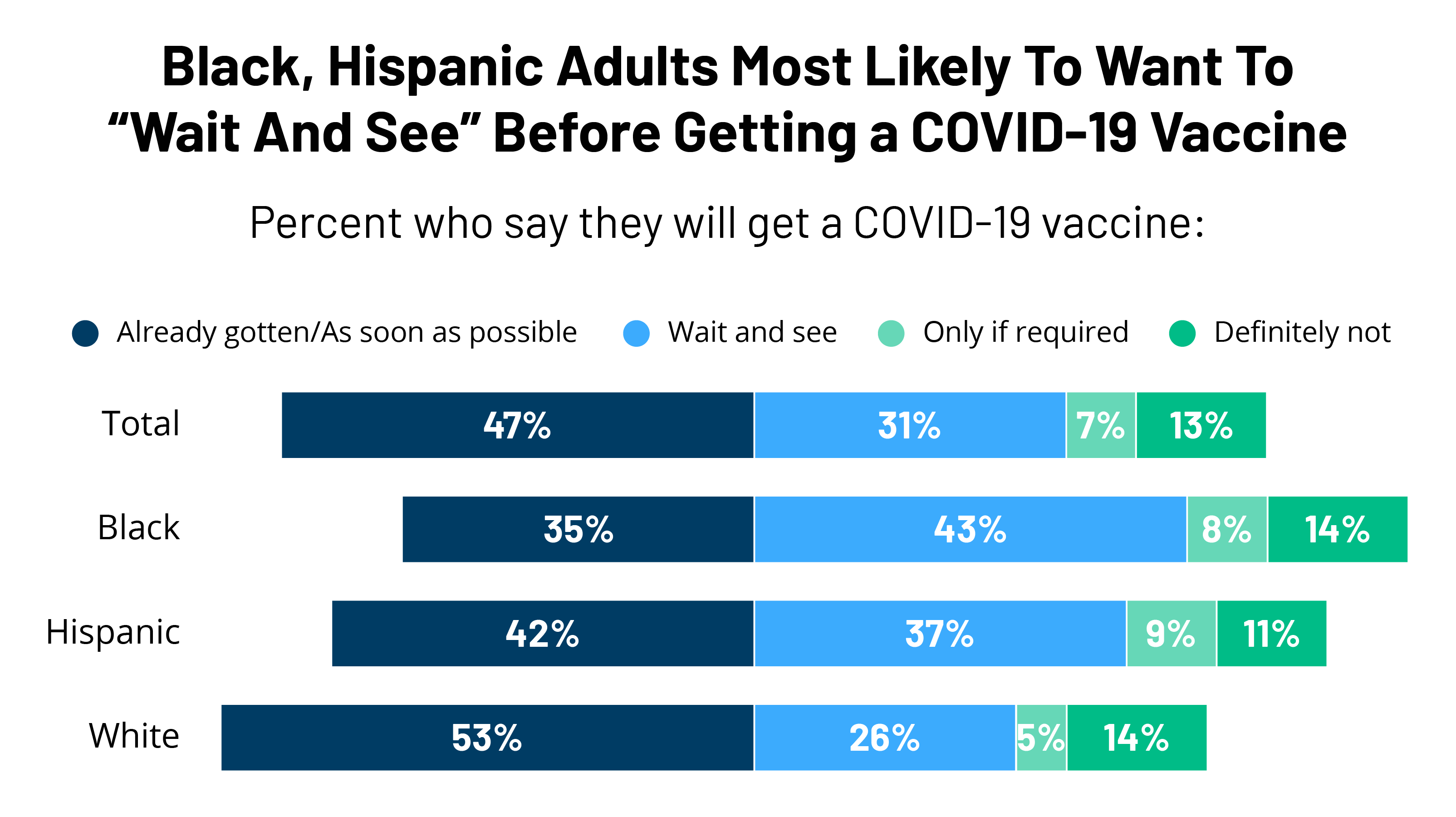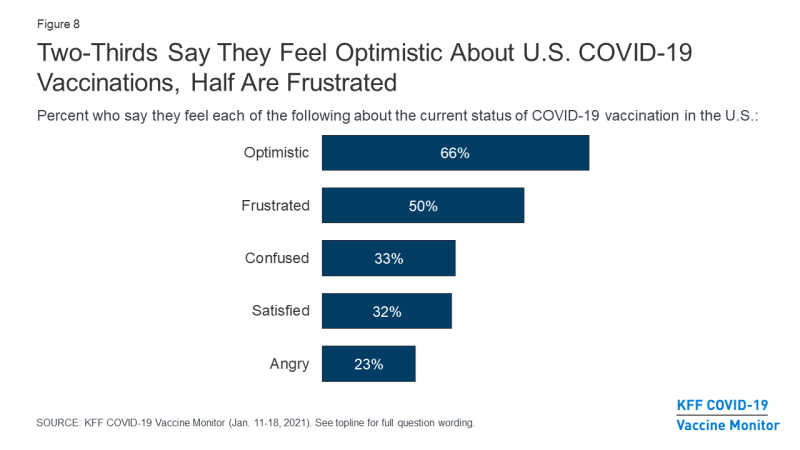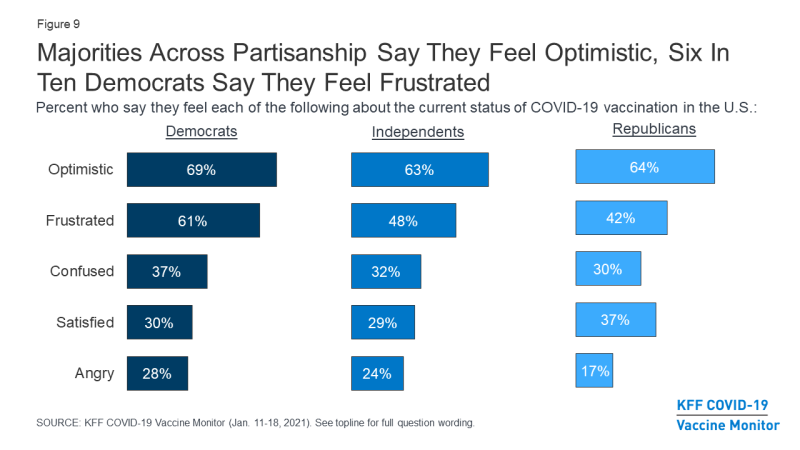The KFF COVID-19 Vaccine Monitor is an ongoing research project tracking the public’s attitudes and experiences with COVID-19 vaccinations. Using a combination of surveys and qualitative research, this project tracks the dynamic nature of public opinion as vaccine development and distribution unfold, including vaccine confidence and hesitancy, trusted messengers and messages, as well as the public’s experiences with vaccination.
Key Findings
- With news reports about states lagging in their vaccine distribution efforts and concerns that the supply of available vaccines will not meet demand, the latest KFF COVID-19 Vaccine Monitor poll (conducted January 11-18) finds two-thirds of U.S. adults (65%) say the federal government is doing a “fair” or “poor” job of distributing vaccines to the states. About three in ten adults give the federal government a positive rating of “excellent” or “good”. Likewise, six in ten think their state government is doing a “fair” or “poor” job of distributing the vaccine to people in their state. Notably, while similar shares across partisans give their state government negative marks, nearly half of Democrats (45%) think the federal government is doing a “poor” job while Republicans are more divided in their assessment.
- About half of the public think that efforts to distribute the vaccine will “get better” under a President Biden Administration, compared to about a third who think efforts will “stay about the same,” and one in ten who say it will “get worse”. Democrats overwhelmingly expect distribution efforts to improve under President Biden (83%) as do a plurality of independents (45%), while most Republicans (57%) say it will remain about the same.
- Two-thirds of adults say they are confident that the COVID-19 vaccines in the U.S. are being distributed fairly, including most Black adults (58%). However, about half of Black adults say they are “not too” or “not at all” confident that the vaccine distribution efforts are taking into account the needs of Black people (52%).
- Majorities of the public who have not yet gotten vaccinated (94% of all adults) say they do not have enough information about when people like them will be able to get the vaccine (60%) and about where they will be able to get the vaccine (55%). Notably, about six in ten Black and Hispanic adults say they do not have enough information about where to get the vaccine, compared to about half of White adults who say the same. Among adults 65 and over – a group that has higher priority for the vaccine – about six in ten say they do not have enough information about when (58%) and where (59%) they will be able to get the vaccine.
- Despite some discontent with government vaccine distribution efforts, two-thirds of the public saying they feel “optimistic” about the current status of vaccinations in the U.S. Though amidst reports of delays in the vaccine rollout in some areas, half also say they feel “frustrated” by the state of the vaccination efforts – including six in ten Democrats (61%), nearly half of independents (48%), and four in ten Republicans (42%). Notably, a third of adults say they feel “confused” by the state of vaccinations in country, which is similar to share who say they feel “satisfied,” indicating there is room for improvement in the first weeks of the Biden Administration.
Most Give Negative Assessment of Federal, State Government Vaccine Distribution Efforts
With news that some states and localities are lagging behind in their distribution efforts and reports that demand for COVID-19 vaccines is outstripping supply, about two-thirds of adults say the federal government is doing a “fair” (33%) or “poor” (31%) job of distributing the COVID-19 vaccines to the states. Just under three in ten give the federal government a positive rating of either “good” (21%) or “excellent” (8%).
State governments also get a negative rating from the public with a majority saying their state government is doing just a “fair” job (36%) or a “poor” job (25%) of distributing vaccines to people in their state while a third say they are doing a “good” (25%) or “excellent” (7%) job.
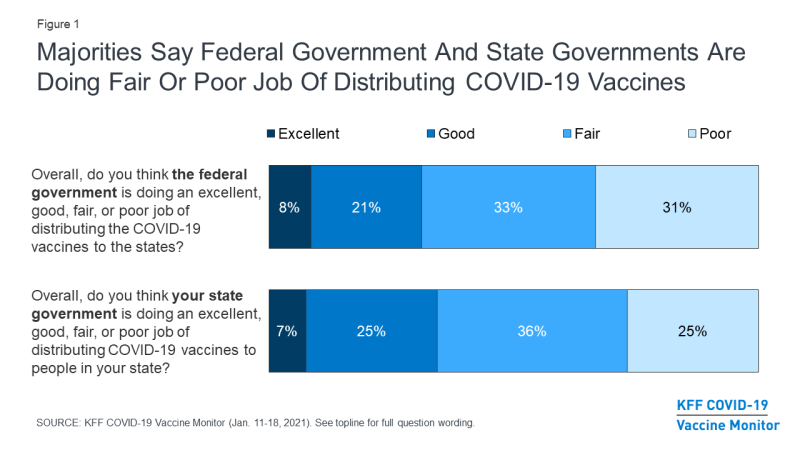
Figure 1: Majorities Say Federal Government And State Governments Are Doing Fair Or Poor Job Of Distributing COVID-19 Vaccines
Notably, Democrats and Republicans give their state governments similar ratings with about six in ten saying they are doing a “fair” or “poor” job distributing the vaccine to people in their state. However, with the survey fielded in the last days of the Trump Administration, partisan opinions are more split when rating the federal government. Eight in ten Democrats say the federal government is doing a “fair” or “poor” job of distributing the COVID-19 vaccines to the states, whereas Republicans are more divided in their rating of the federal government (43% say “excellent” or “good”, and 46% “fair” or “poor”).
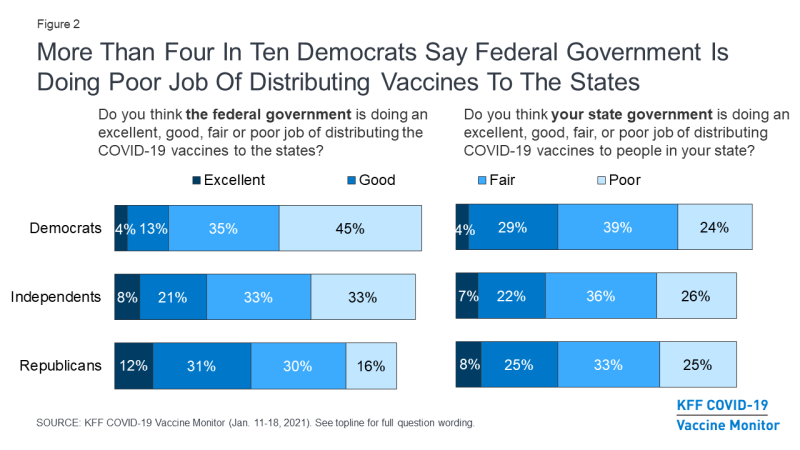
Figure 2: More Than Four In Ten Democrats Say Federal Government Is Doing Poor Job Of Distributing Vaccines To The States
About half of adults (48%) think efforts to distribute the vaccine in the U.S. will “get better” under the new President Biden Administration. About a third (36%) say they think vaccine distribution efforts will “stay about the same” while 12% say it will stay “get worse.” An overwhelming majority of Democrats (83%) think vaccine distribution efforts will “get better” under the Biden Administration while a majority of Republicans (57%) think distribution efforts will remain “about the same.” About four in ten independents (45%) expect distribution efforts to improve under President Joe Biden while 38% think it will “stay about the same.”
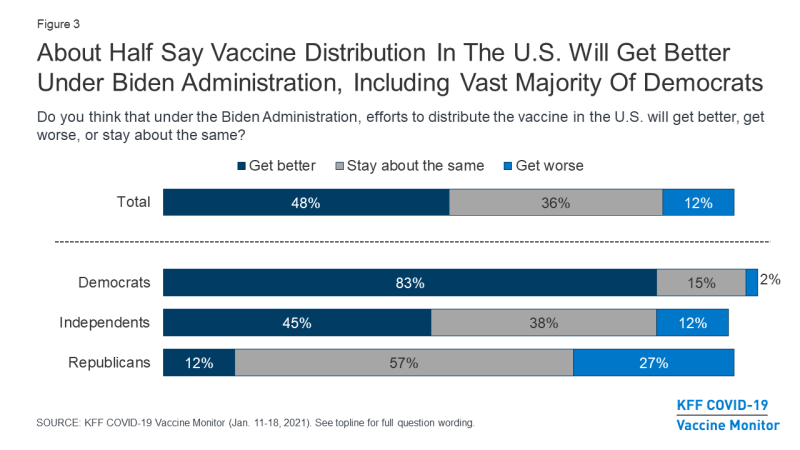
Figure 3: About Half Say Vaccine Distribution In The U.S. Will Get Better Under Biden Administration, Including Vast Majority Of Democrats
Despite some discontent with the vaccine distribution efforts of the federal government and state governments, most adults (65%) – including majorities across Democrats (70%), independents (64%), and Republicans (59%) – are confident that vaccines are being distributed in a way that is fair. About a third of the public say they are “not too confident” (20%) or “not at all confident” (12%) that the COVID-19 vaccines are being distributed fairly. In the December KFF COVID-19 Vaccine Monitor, fielded before COVID-19 vaccinations began in the U.S., a similar share of adults (67%) expressed confidence that the vaccine would be distributed in a fair manner.
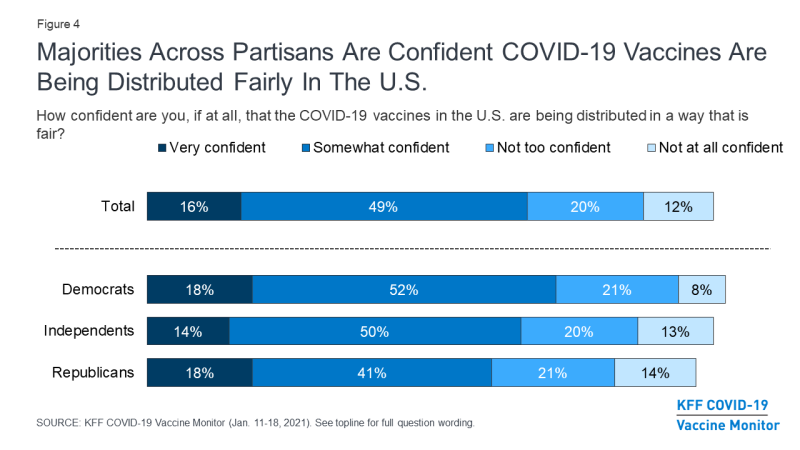
Figure 4: Majorities Across Partisans Are Confident COVID-19 Vaccines Are Being Distributed Fairly In The U.S.
Nonetheless, while the public overall expresses confidence that the vaccines are being distributed fairly, concerns remain about whether the needs of people of color are being taken into account in the vaccine distribution process. While most Black adults (58%) are at least “somewhat confident” that the vaccine is being distributed fairly in the U.S., just 9% are “very confident” that is the case. Indeed, about half of Black adults (52%) say they are “not too” or “not at all” confident that the distribution of a COVID-19 vaccine is taking the needs of Black people into account. While most about half of Hispanic adults (53%) express some confidence that the needs of Hispanic people are being taken into account in the distribution of the vaccine, a large share (44%) say they are “not too confident” or “not at all confident.”
In KFF’s December 2020 COVID-19 Vaccine Monitor, half of Black adults (49%) and six in ten Hispanic adults (60%) said they were confident that the development of the vaccine was taking into account the needs of Black and Hispanic people respectively.
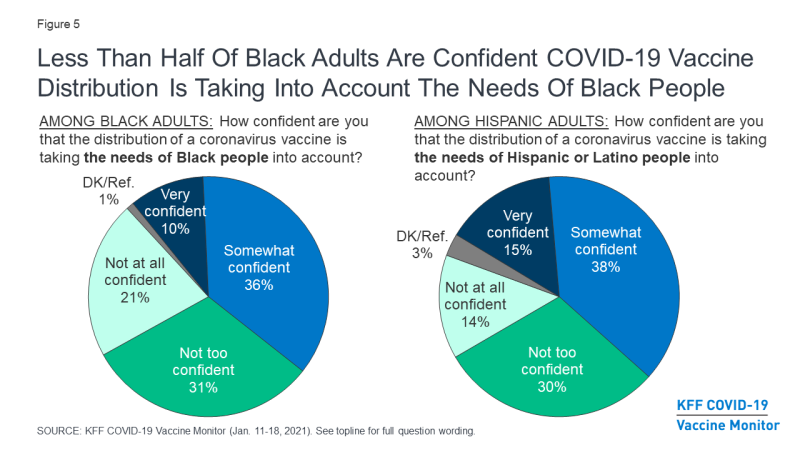
Figure 5: Less Than Half Of Black Adults Are Confident COVID-19 Vaccine Distribution Is Taking Into Account The Needs Of Black People
Majorities Say They Do Not Have Enough Information About Where And When To Get Vaccine
Among those who have not yet gotten the COVID-19 vaccine (94% of all adults), six in ten say they do not have enough information about when people like them will be able to get the vaccine. Information on where to get a vaccine is also needed as a majority (55%) of those who are not yet vaccinated say they do not have enough information about where they will get a vaccine. Despite some states having slightly different vaccine priority criteria, most adults (55%) say they have enough information about how their state is deciding who gets priority for the COVID-19 vaccine, with four in ten (43%) saying they do not have enough information.
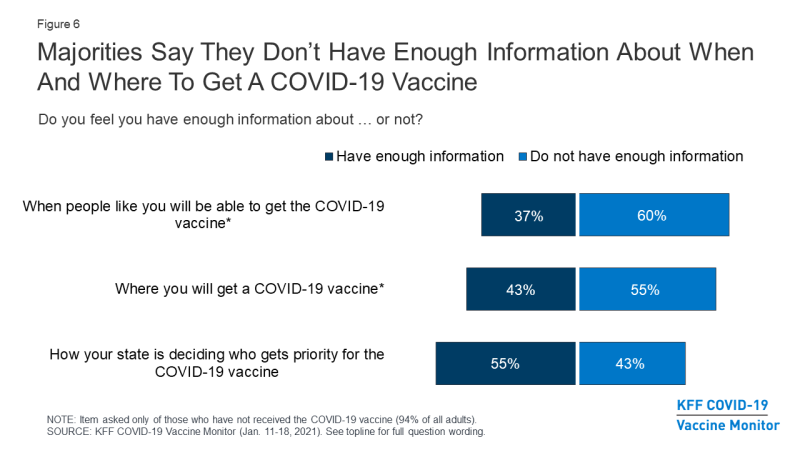
Figure 6: Majorities Say They Don’t Have Enough Information About When And Where To Get A COVID-19 Vaccine
Adults 65 and older are among the groups many states are prioritizing for vaccine distribution. However, among those older adults who have not yet been vaccinated, about six in ten say they do not have information about when people like them will be able to get the COVID-19 vaccine (58%) and about where they will be able to get it (59%). Notably, a majority of essential workers who have not yet gotten the vaccine say they have enough information about where to get the vaccine (55%), but most say they do not have enough information about when people like them will be able to get vaccinated (55%). This includes health care workers (one-fifth of essential workers work in a health care delivery setting) who have not yet gotten vaccinated and say they don’t have enough information about when they will be able to get vaccinated (21%). A similar share (18%) of health care workers haven’t gotten vaccinated and say they don’t have enough information about where to get vaccinated.
About six in ten Black (62%) and Hispanic (63%) adults say they do not have enough information about where to get a COVID-19 vaccine, compared to about half of White adults who say they do not enough information (51%). Six in ten lower income adults with a household income under $40,000 (61%) say they do not have enough information about where they will be able to get a vaccine, compared to about half of those with a household income of $90,000 or more (49%). Similarly, lower income adults are also less likely than their higher income counterparts to say do not have enough information about when people like them will be able to get the vaccine (66% vs. 54%).
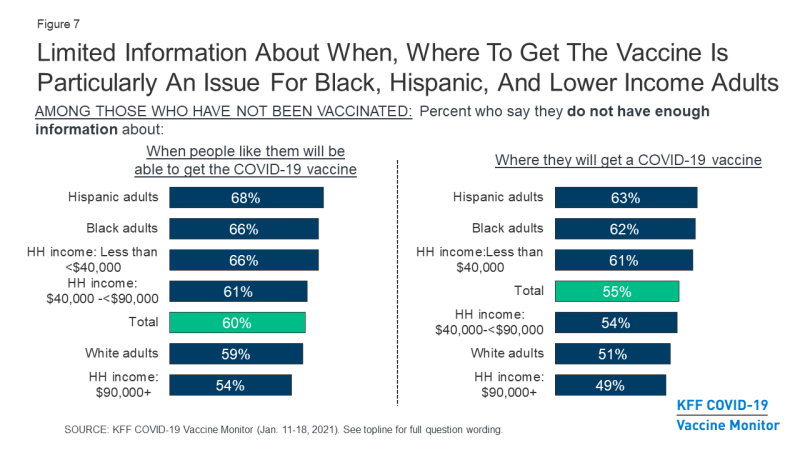
Figure 7: Limited Information About When, Where To Get The Vaccine Is Particularly An Issue For Black, Hispanic, And Lower Income Adults
Public Is Optimistic About COVID-19 Vaccination Efforts, Though Some Concerns Remain
With millions of health care workers, long term care workers and residents, and older adults throughout the country getting vaccinated against COVID-19, two-thirds of the public (66%) say they feel “optimistic” about the current status of vaccinations in the U.S. Nonetheless, perhaps reflecting the negative ratings given to the federal and state government vaccine distribution efforts, half of the public (50%) say they feel “frustrated” with the current status of COVID-19 vaccinations in the country. Additionally, one-third of adults say they feel “confused” about the status of vaccinations, including about four in ten Black adults (46%), young adults ages 18 to 29 (40%), and those with a household income under $40,000 (42%). A third of the public say they feel “satisfied” about current status of vaccinations in the U.S. while about one in four say they feel angry (23%).
| Percent who say each of the following describes how they feel about current status of COVID-19 vaccination in the U.S.: | Age | Race/Ethnicity | |||||
| 18-29 | 30-49 | 50-64 | 65+ | Black | Hispanic | White | |
| Optimistic | 64% | 66% | 63% | 70% | 65% | 70% | 65% |
| Frustrated | 48 | 46 | 55 | 53 | 55 | 42 | 52 |
| Confused | 40 | 30 | 32 | 33 | 46 | 38 | 31 |
| Satisfied | 32 | 27 | 29 | 41 | 31 | 43 | 30 |
| Angry | 25 | 20 | 26 | 23 | 22 | 24 | 23 |
Optimism about vaccinations crosses party lines with about two-thirds of Democrats, independents, and Republicans saying they feel optimistic about the current status of vaccinations in the country. However, despite the shared optimism, about six in ten Democrats (61%) also say they are frustrated, compared to less than half of Republicans (42%) and independents (48%) who say the same.

